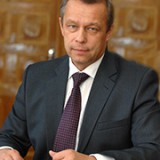UDC: 796.062
BBC: 75.4(2Рос)
Snytkin D.V.
Achievement of national development goals in the field of physical education and sport
Keywords: physical culture and sport, physical culture and sports services, physical culture and sports institutions, physical culture and sports organizations, national development goals
The article is devoted to studying the role of physical culture and sports institutions in achieving national goals. The relevance of this article is due to the trend towards popularization of healthy lifestyle and physical education and sports, which is reflected in documents of strategic planning of the Russian Federation. The study aims to investigate the role of physical culture and sports institutions in achieving national goals. Materials and methods. The article uses general research methods. The sources used are legal and regulatory acts, statistical publications, as well as scientific research in the field of sports management. The article considers the main legal and regulatory acts, which set national development goals of Russia such as the Presidential Decree of 2 July 2020 № 474 (no longer valid) and the Presidential Decree of 7 May 2024 № 309, Presidential Message of 29 February 2024, as well as the sector strategy of the Ministry of Sport of the Russian Federation «Strategy-2030». Infrastructure provision of sports sector – sports clubs, swimming pools and sports grounds – has been investigated. Results of the study. The paper analyzed the changes in the number of sports facilities in Russia from 2000 to 2022 and in the number of physical culture and sports institutions, which have a tendency to decrease. It studied the dynamics of the number of people who practice sports in sports sections, the index of physical volume of paid services for the population, as well as the level of prices for sports goods and services in Russia. It was established that the number of physical education and sports organizations approved by the Ministry of Sport of the Russian Federation with the possibility of tax deduction is declining. Despite the reduction of organizations, there is an increase in the main indicators of achievement of national goals of the Russian Federation. The proportion of the population that is permanently engaged in physical culture and sport increases, as does the volume of paid services in the field of physical culture. The physical culture services have been largely unaffected by sanctions, as evidenced by the increase in the volume of paid services and the fact that prices are rising steadily below inflation. In terms of stimulating the population, the reduction of organizations listed by the Ministry of Sports of the Russian Federation is a negative trend, since tax deduction makes the acquisition of services of physical culture and sports organizations more attractive. The decline in the number of such organizations may indirectly affect the effectiveness of physical education. Despite the decline in the number of sports organizations, the physical volume of paid services for the population in the field of physical culture and sport has increased, as has the number of practitioners in sports sections. Conclusions. Physical culture and sports institutions play a key role in popularizing a healthy lifestyle, creating conditions for the physical development of citizens. The state actively supports the development of the industry, financing the construction of facilities and attracting private investment. Additionally, demand for services is stimulated by means of tax deduction for accredited institutions. Despite the decrease in the number of organizations under OKVED 93, the number of citizens regularly involved in sports is increasing. National goals and industry strategies are being implemented according to the plan.
References
- Dostizhenie pokazatelei Strategii 2030 po itogam 2023 goda [Achieving the indicators of the 2030 Strategy by the end of 2023]. Available at: https://emir.gov.ru/analytics/indicators/list (Accessed Date: 2024, Sept. 1).
- Edinyi plan po dostizheniyu natsional’nykh tselei razvitiya Rossiiskoi Federatsii na period do 2024 goda i na planovyi period do 2030 goda [A unified plan to achieve the national development goals of the Russian Federation for the period up to 2024 and for the planning period up to 2030]. Available at: https://www.economy.gov.ru/material/file/ffccd6ed40dbd803eedd11bc8c9f7571/Plan_po_dostizheniyu_nacionalnyh_celey_razvitiya_do_2024g.pdf (Accessed Date: 2024, Aug. 30).
- Indeksy potrebitel’skikh tsen na tovary i uslugi [Consumer price indices for goods and services]. Available at: https://www.fedstat.ru/indicator/31074 (Accessed Date: 2024, Aug. 30).
- Kovalenko E.Yu.,, Shavandina O.A., Tydykova N.V. Osobennosti gosudarstvennogo regulirovaniya i upravleniya v sfere fizicheskoi kul’tury i sporta [Features of state regulation and management in the field of physical culture and sport]. Rossiisko-aziatskii pravovoi zhurnal, 2022, no. 2, pp.17–24.
- Kolesnik I.A. Upravlenie sferoi fizicheskoi kul’tury i sporta v Omskoi oblasti: problemy i perspektivy razvitiya [Management of the physical culture and sports in the Omsk region: challenges and prospects]. Mezhdunarodnyi zhurnal gumanitarnykh i estestvennykh nauk, 2021, no. 3-1(54), pp. 58–61.
- Kolichestvo organizatsii po dannym gosudarstvennoi registratsii s 2017 g. [The number of organizations according to the state registration data since 2017]. Available at: https://www.fedstat.ru/indicator/58109 (Accessed Date: 2024, Aug. 30).
- Miftahov M.R. Effektivnost’ provodimoi regional’noi politiki v oblasti fizicheskoi kul’tury i sporta (na primere sub”ektov Privolzhskogo federal’nogo okruga Rossiiskoi Federatsii) [Effectiveness of the implemented regional policy in the field of physical culture and sport (on the example of the subjects of the Volga Federal District of the Russian Federation)]. Ekonomicheskie nauki, 2020, no. 193, pp.335–342.
- Parshikova N.V., Izaak S.I., Kovalenko G.V. Sport v mezhdunarodnoi sisteme koordinat: novye vyzovy i vozmozhnosti [Sport in the international coordinate system: new challenges and opportunities]. Teoriya i praktika fizicheskoi kul’tury, 2017, no. 7, pp. 94–96.
- Parygin A.V., Fitina L.N. Kompleks mer po vovlecheniyu naseleniya razlichnykh grupp v zanyatiya fizicheskoi kul’turoi i massovym sportom na primere goroda Ekaterinburga [Set of measures to involve the population of different groups in physical culture and mass sports, as a example of the city of Ekaterinburg]. Sovremennyi uchenyi, 2020, no. 5, pp. 18–23.
- Perechni fizkul’turno-sportivnykh organizatsii [Lists of physical culture and sports organizations]. Available at: https://minsport.gov.ru/activity/mass-sport/perechni-fizkulturno-sportivnyh-organizaczij (Accessed Date: 2024, Aug. 29).
- Rasshirennyi poisk po yuridicheskim litsam [Advanced search for legal entities]. Available at: https://pb.nalog.ru/ (Accessed Date: 2024, Aug. 30).
- Rol’ sporta v dostizhenii tselei v oblasti ustoichivogo razvitiya [The role of sport in achieving the Sustainable Development Goals]. Available at: https://www.un.org/ru/chronicle/article/21938 (Accessed Date: 2024, Aug. 30).
- Rossiiskii statisticheskii ezhegodnik. 2023: Statisticheskii sbornik [Russian Statistical Yearbook]. Moscow, 2023, 701 p.
- Sedov I.S., Chikanov P.V. Fizicheskaya kul’tura i sport kak faktor obespecheniya natsional’noi bezopasnosti [Physical culture and sport as a factor in national security]. Ekonomika i sotsium, 2020, no. 12(79), pp. 118–
- Chislennost’ grazhdan, zanimayushchikhsya vidami sporta i dvigatel’noi aktivnost’yu [The number of citizens engaged in sports and physical activity]. Available at: https://emir.gov.ru/analytics/indicators/sports-development/rf (Accessed Date: 2024, Aug. 30).
About authors
- Snytkin Dmitriy V.
- Post-Graduate Student, Department of Russian and Regional Economy, Plekhanov Russian University of Economics, Russia, Moscow (snytkindv@mail.ru; )
Article link
Snytkin D.V. Achievement of national development goals in the field of physical education and sport [Electronic resource] // Oeconomia et Jus. – 2025. – №1. P. 54-64. – URL: https://oecomia-et-jus.ru/en/single/2025/1/5/. DOI: 10.47026/2499-9636-2025-1-54-64.

